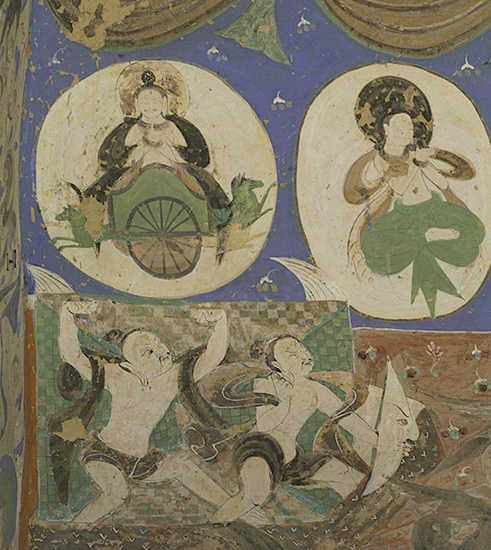 |
|
The image of Apollo with a Chinese face (left upper corner) found in Cave 285 reflects ancient Dunhuang's multiculturalism. [Photo provided to China Daily] |
Bridging the gap
When Schmid was hired, Wang expected him to be "a bridge and resource for international scholars, who come to Dunhuang for research".
A language barrier still exists, as an official announcement by the academy on his appointment states. Critical literature on Dunhuang studies in China is not widely translated and is, therefore, limited to academics who can read Chinese.
The American Sinologist now has an ambitious project ahead of him.
Schmid is preparing The Comprehensive Guide to Scholarly Resources for Dunhuang Studies, the first-ever encyclopedic reference for international scholars in the field. It will include introductions to text resources, sociological methodologies, linguistics, religion and philosophy.
He adds that digitization also makes in-depth interdisciplinary studies possible.
The Sinologist points out that Dunhuang provides significant inspiration for cultural exchanges today.
"Dunhuang is cosmopolitan," Schmid says. "Even if you go there 100 times, you will always learn something new."
He points out that, in Cave 285, for example, there are Taoist motifs and images of Apollo with a Chinese face alongside the Hindu deities of Vishnu and Ganesha, even though the cave is designed to worship Buddha.
"Different religions can exist in one space, and they mix," Schmid explains. "Dunhuang is a model for different civilizations and ideas to come together without conflict.
"Nowhere in the world does a comparable collection of such a complex set of resources exist from the past. Therefore, these materials offer the profound potential to help us understand the past, ourselves in the present and the possibilities for a globalized future."
He believes that studying Dunhuang with a long vision will help people break ethnocentric stereotypes.
Still, there is a long way to go to improve public knowledge of Dunhuang in the West, despite the booming academic interest.
"When friends and family ask what I research, I mention a unique archaeological site on the Silk Road in the far west of China," he wrote in an article in 2014.
"Few know Dunhuang or certainly Mogao, but in the unfurrowed ground of ignorance lies the wealth of potential harvests."
New ideas have been developed to fill this gap. For example, Schmid has cooperated with Getty Museums in Los Angeles over the past two years to bring artists and musicians to Dunhuang to find inspiration.
"I would say it (Dunhuang) is very seductive. People are interested because it's all about humanity," Schmid says.
Schmid also reveals to China Daily that there will be a new docudrama on Dunhuang, and an American opera director has turned to him for help in preparing a production in which Buddhist sutras from some of the murals are featured.
"We have a responsibility to ensure the inestimable value of these truly incomparable materials are made known to, and available to, the world," he says.
(China Daily 07/16/2019 page20)